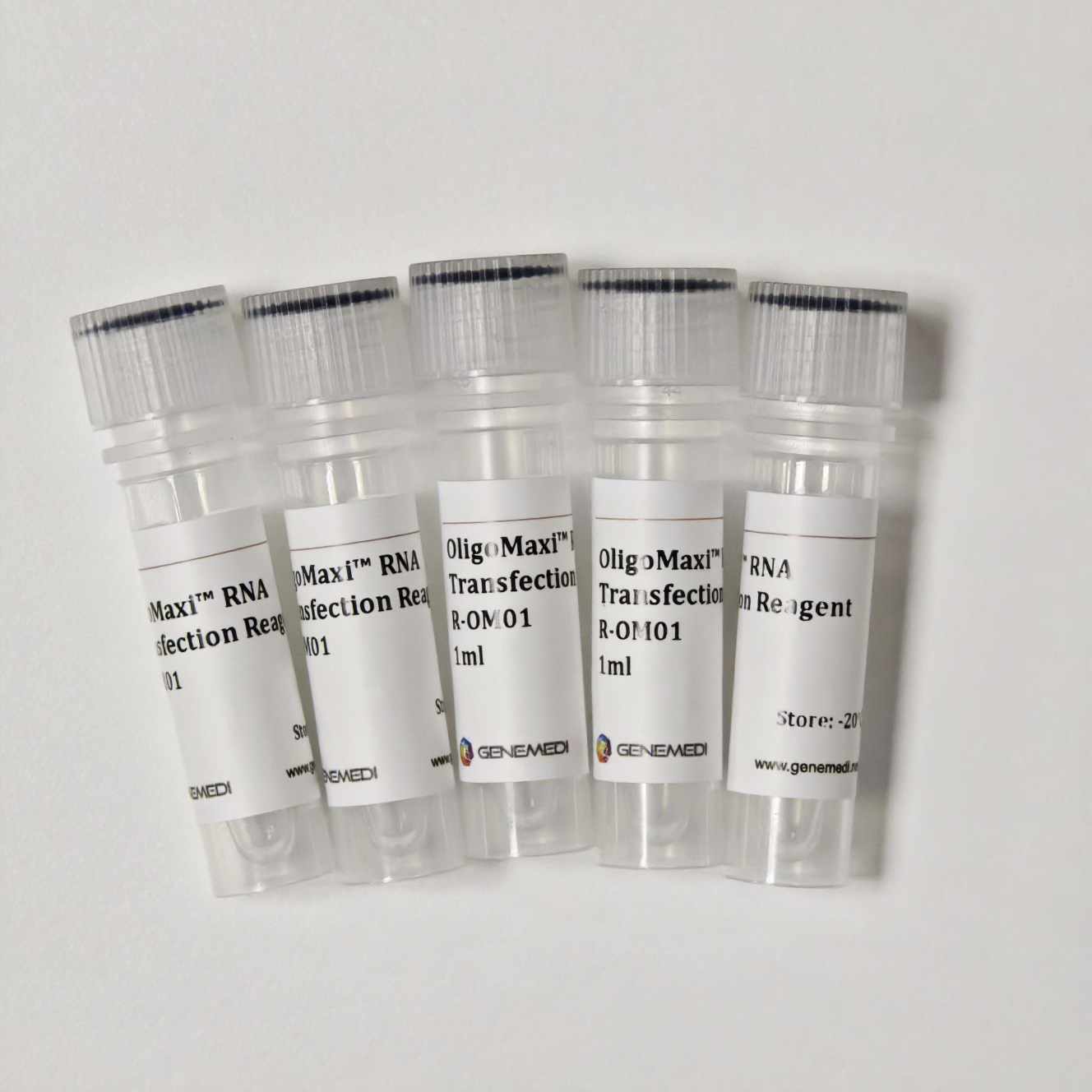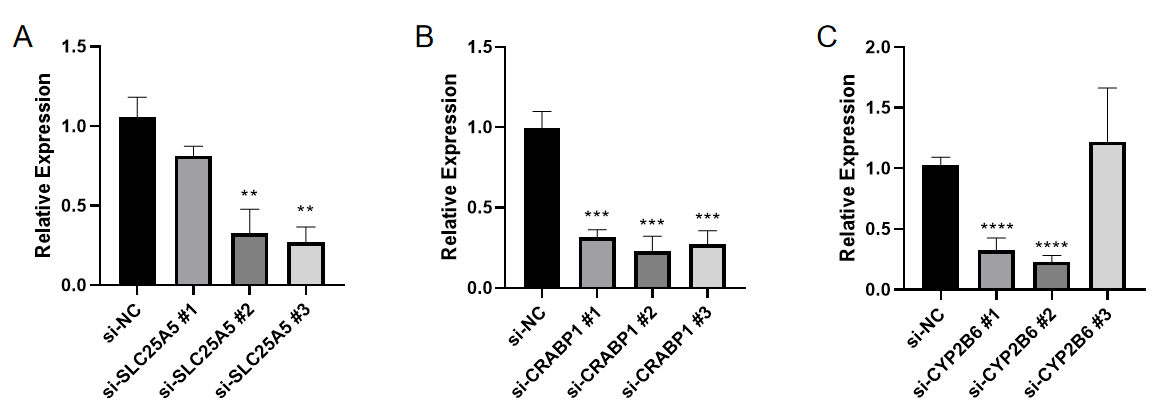
-
High Efficiency: >90% in most cell lines, including hard-to-transfect cells.
-
Low Cytotoxicity: Maintain cell health without media changes.
-
Broad Compatibility: For adherent and suspension cells.
OligoMaxi™ RNA Transfection Reagent
High-Efficiency siRNA/miRNA Delivery for Mammalian Cells
Powerful and Versatile Small RNA Delivery
OligoMaxi™ RNA transfection reagent is a powerful siRNA/miRNA transfection reagent designed to ensure highly efficient and reproducible delivery of various small RNAs into mammalian cells. With OligoMaxi™, even at low siRNA concentrations, over 90% transfection efficiency can be achieved in most cell types (e.g., HeLa, MCF7, or NIH-3T3).
For hard-to-transfect suspension cells like K562 and THP-1, OligoMaxi™ still delivers outstanding performance, with transfection efficiency exceeding 80%. Its proprietary formulation ensures minimal cytotoxicity, allowing for healthy cell cultures post-transfection, even without a media change, making it ideal for sensitive experiments and high-throughput screening.
Product Specifications
| Product Name | OligoMaxi™ RNA Transfection Reagent |
| Catalog Series | R-OM Series (R-OM01 to R-OM04) |
| Application | siRNA, miRNA, small RNA transfection |
| Cell Types | Adherent & Suspension Mammalian Cells |
| Transfection Efficiency | >90% in adherent cells, >80% in suspension cells |
| Storage | Store at 4°C. Do not freeze. |
| Shipping | Ships on blue ice / ice packs |
| Shelf Life | 1 Year from date of receipt when stored properly |
Technical Documents
Validation Data
GeneMedi's OligoMaxi™ RNA Transfection Reagent ensures highly efficient and reliable RNA delivery with minimal cytotoxicity. It enables uniform siRNA uptake across cell populations, achieving strong fluorescence signals that confirm excellent transfection efficiency. This reagent provides a robust and reproducible solution for RNA-based applications.

A–C. Bright-field microscopy images of HEK293 cells post-transfection, showing preserved cell morphology and minimal cytotoxicity.
D–F. Fluorescence microscopy images of HEK293 cells post-transfection, revealing strong and uniform red fluorescence signals, indicating near-complete siRNA uptake across the cell population. These results demonstrate the high efficiency and reliability of OligoMaxi™ for siRNA delivery.
GeneMedi's OligoMaxi™ RNA Transfection Reagent in combination with PromiseDown™ siRNA Oligos enables highly efficient and reproducible RNA interference (RNAi) for gene silencing applications. Using a stable EGFP-expressing HEK293 cell line as a model, multiple siRNA sequences targeting distinct EGFP regions were delivered with OligoMaxi™ RNA Transfection Reagent, resulting in a marked reduction of fluorescence, indicative of robust and consistent gene silencing. The reagent provides high transfection efficiency, uniform siRNA delivery, low cytotoxicity, and excellent reproducibility, making it a superior choice for RNAi-based studies.

A. Control HEK293 cells stably expressing EGFP, showing strong baseline green fluorescence.
B–F. HEK293 cells transfected with PromiseDown™ siRNA oligos using OligoMaxi™, demonstrating substantially reduced fluorescence compared with control.
GeneMedi's PromiseDown™ siRNA Oligo demonstrate potent and sequence-specific knockdown efficiency across multiple gene targets.
Multiple independent sequences against SLC25A5, CRABP1, and CYP2B6 were transfected into HEK293 cells using OligoMaxi™ RNA Transfection Reagent. Quantitative RT-PCR confirmed that these siRNAs significantly and reproducibly decreased target gene expression, further validating their effectiveness in mediating RNA interference.

Relative mRNA expression of SLC25A5 (A), CRABP1 (B), and CYP2B6 (C) following transfection with three distinct siRNA sequences per gene compared with non-targeting control siRNA (si-NC).
A. Quantitative RT-PCR analysis confirmed that all three si-SLC25A5 constructs significantly suppressed target gene expression, with si-SLC25A5 #2 and #3 exhibiting the most pronounced knockdown.
B. Quantitative RT-PCR demonstrated that si-CRABP1 #1–3 consistently reduced CRABP1 mRNA levels with high efficiency.
C. For CYP2B6, qRT-PCR analysis showed that si-CYP2B6 #1 and #2 produced marked reductions in gene expression, whereas si-CYP2B6 #3 demonstrated only moderate silencing activity.
Overall, PromiseDown™ siRNAs delivered by OligoMaxi™ achieved robust, consistent, and sequence-specific knockdown across multiple gene targets.
Frequently Asked Questions
What is the siRNA and how do they work?
siRNAs are short, noncoding, double-stranded RNAs that leverage the RNA interference (RNAi) pathway to achieve highly specific gene silencing. They suppress gene expression by targeting and selectively degrading complementary messenger RNA (mRNA), through RNA-induced silencing complex (RISC).
How do I order siRNAs?
You may order siRNAs through our website. The desired target can be searched by Symbol, Gene No, accession Number. Each query will yield three candidates. You may select the desired quantity at that point.
Can I order siRNAs targeted for a specific gene?
You may order siRNAs for the target gene of your choice by entering the gene name or Accession number at our website and selecting one of the listed siRNA candidates. You may also order custom designed siRNA if your model organism is not Human, Mouse or Rat. You can also order siRNAs by sequences, please email us.
What form will my order be in?
For siRNAs, both the sense and antisense strands are synthesized at equimolar concentrations, then annealed and delivered in duplexed, lyophilized form. EPDC-treated water with every order. We recommend reconstituting to 100μM.
I want to conduct an in vitro experiment. What scale should I choose? What purification should I select?
With a 2.5 nmol scale siRNA order, you can transfect ten 24-well plates at 20μM per transfection. For in vitro experiments, the standard small-scale purification method is OPC desalt. For in vivo experiments, HPLC purification is required. For in vivo experiments, HPLC purification is required.
I would like to know how the synthesized siRNA is purified.
To purify newly synthesized siRNA, we have several methods including OPC, HPLC and PAGE. We select a purification method depending on the end-use of the product:
In vitro experiments, OPC purification is enough for use.
in vivo experiments, HPLC is commonly used to reach the desired purity level. We use a reversed-phase resin for HPLC purification, and this will routinely yield up to 90% purity for 21-mer siRNA molecules.

